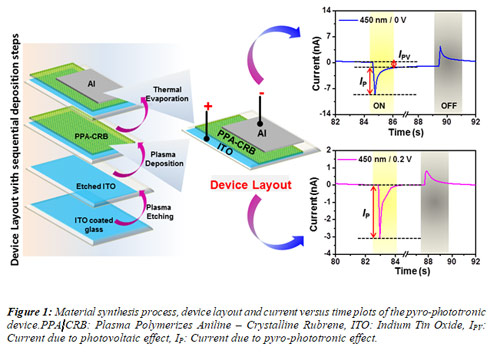 Scientists at the Institute of Advanced Study in Science and Technology (IASST), an autonomous institute of the Department of Science & Technology, have found a new process for synthesizing crystalline rubrene, a polycyclic aromatic hydrocarbon-based thin film which can be useful for the development of optoelectronic devices and also for preparation of Electronic Skin (E-Skin).
Scientists at the Institute of Advanced Study in Science and Technology (IASST), an autonomous institute of the Department of Science & Technology, have found a new process for synthesizing crystalline rubrene, a polycyclic aromatic hydrocarbon-based thin film which can be useful for the development of optoelectronic devices and also for preparation of Electronic Skin (E-Skin).
The new synthesis is a water-free, solvent-free, environmentally friendly one-step plasma process. The resultant crystalline rubrene based film demonstrated optoelectronic properties, and an Indian patent has been filed for the process. A highly uniform pin-hole-free thin film can be deposited by this process, which is useful for fabrication of high-end devices.
Devices made of pyro-electric materials (that generate electric charge when they are heated or cooled) and piezo-electric materials (that generate electric charge under the effect of mechanical pressure), can help detect change in temperature and pressure. Pyro-electric materials also show pyro-phototronic effect where pyro-electricity is associated with the change in temperature of a material when it absorbs photons. Pyro-electric infrared detectors are well known for application in infrared sensing for space research, defense, remote sensing, and household appliances.
These kinds of materials are available in biological systems such as – human skin, plant cellulose leading to their significance in the understanding of basic science of biological systems and also in their huge application prospect.
The present study conducted by the IASST team published in Journal of Materials Chemistry revealed that centro-symmetric rubrene crystal has a thin amorphous oxide layer formed over the crystalline film. This induces surface layer polarization effect leading to pyro-phototronic effect.
This work delivered a new experimental approach for synthesis of crystalline rubrene film and realization of pyro-phototronic effect on a fully organic crystalline medium with rubrene for the first time. It also circumvents the essentiality of materials to be non-centrosymmetric to show pyroelectric behaviour.
According to the IASST team, formation of crystalline rubrene at sufficiently high Radio Frequency(RF) plasma power confirmed that with increasing applied RF power, a phase transition from amorphous to crystalline rubrene can be obtained. This oxide layer over the crystalline rubrene film that causes surface polarization is formed after exposure of the deposited film in air due to film surface oxidation.
Since last few years, scientists from around the world are working on the synthesis of organic materials for electronic applications. The conventional process for synthesis of organic electronic materials based on chemical processes provides very good quality materials, but the stability of the materials is not very good, and it requires use of solvents. Moreover, multiple steps are required for material synthesis and film deposition. To overcome these challenges, the IASST team has been working on plasma-based process due to the unique advantages of such process over the conventional processes of organic electronics.
This novel process developed by the IASST team, besides being useful for developing advanced optoelectronic devices and preparation of Electronic Skin (E-Skin), may be useful as a tool for laboratory simulation of different biological systems for probing the organization and dynamics of those systems.
Publication: DeepshikhaGogoi, Amreen A Hussain, Sweety Biswasi and Arup R Pal, Journal of Materials Chemistry C, (2020) DOI: 10.1039/D0TC00857E
Indian Patent, Application No. 201931016529 dated 25-04-2019.
For more details contact Dr. Arup R. Pal: E-mail: arpal[at]iasst[dot]gov[dot]in, Phone: 99571-74421






























